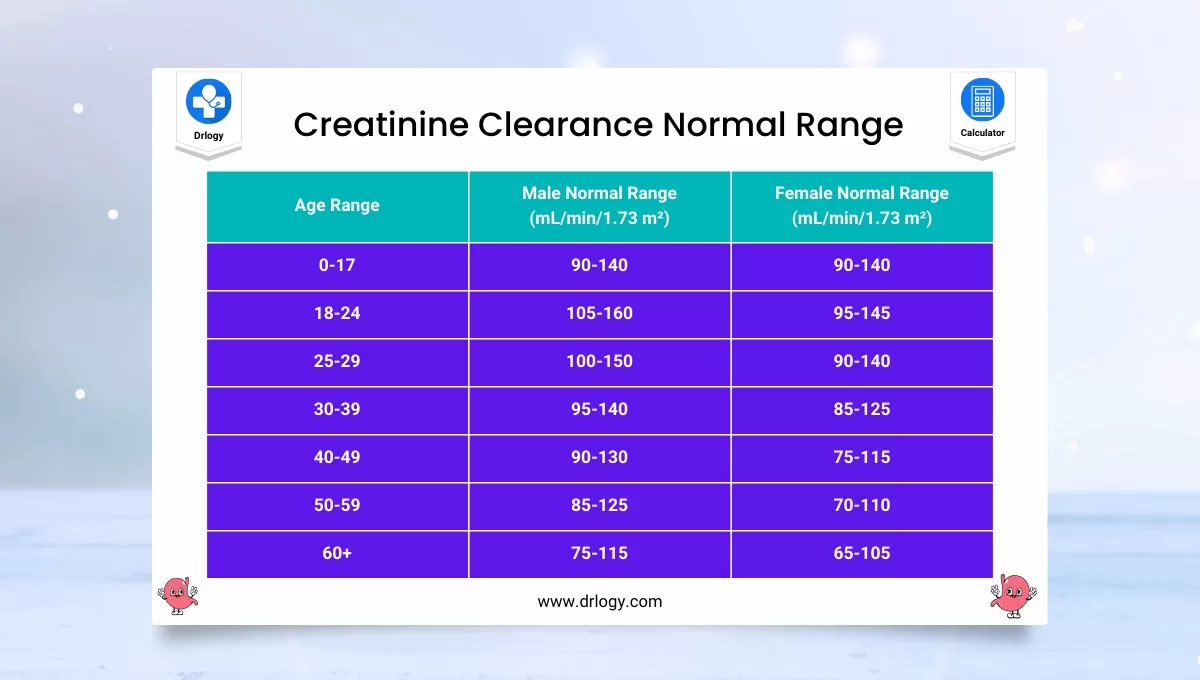Body Measurements
Blood & Cholesterol
Medical Measurements
Body Measurements
Health Scores
Temperature & Time
Miscellaneous Conversions
Small Mammal Pregnancy
Sheep & Mare Gestation
Swine & Livestock Gestation
Doctors Nearby Me
Top Healthcare Professionals
Lab Tests
Health & Medical Days
Calculator
Drlogy Hospital Software
Drlogy Specialty Software
Drlogy Pathology Lab Software
1000+ Pathology Lab Report Format
Drlogy Radiology Software
Drlogy Free Profile Listing
Drlogy Letterhead
Drlogy ICD Codes

Result
Below age-matched normal range
| Age Range | Normal Range (mL/min/1.73 m²) |
|---|---|
| 0 - 17 | 90 - 140 |
| 18 - 24 | 105 - 160 |
| 25 - 29 | 100 - 150 |
| 30 - 39 | 95 - 140 |
| 40 - 49 | 90 - 130 |
| 50 - 59 | 85 - 125 |
| ≥ 60 | 75 - 115 |
Consult your doctor for further investigation.
Here are 5 steps to calculate Creatinine Clearance Calculator:
Here is a formula to calculate Creatinine Clearance Calculator using Cockcroft-Gault Formula
Creatinine Clearance = (140-age) x (Wt in kg) x sex / (72 x sCr)
The coefficient sex equals 1 for males or 0.85 for females.
Adult (< 40 years) reference ranges for creatinine clearance are as follows :
The reference range in newborns is 40-65 mL/min.
The Glomerular Filtration Rate (GFR) is declines, values fall 6.5 mL/min/decade of life.
Normal value ranges may vary slightly among different laboratories. Some labs use different measurements or test different samples. Talk to your doctor to know about the meaning of your specific test results.

Abnormal results (lower than normal creatinine clearance) may indicate:
Creatinine is tested by two main ways in blood and urine. To use creatinine tests to measure kidney function:
Doctors use serum creatinine and eGFR to check how well your kidneys work. As kidney function gets worse, GFR also goes down.
Your doctor may also order a creatinine test if you have symptoms of kidney disease, including:
Because serum creatinine undergoes tubular secretion, any medications that interfere with this process will falsely elevate the patient's serum creatinine; however, this will not impact the patient's true GFR. The following medications have been shown to falsely elevate serum creatinine:
Certain patient groups have dramatically different serum creatinine production or elimination compared to the normal patient population. The following groups are notoriously difficult to estimate true renal function:
There is little risk involved with having your blood taken. Veins and arteries vary in size from one person to another and from one side of the body to the other. Taking blood from some people may be more difficult than from others.
Other risks associated with having blood drawn are slight, but may include:
Summary
Overall, Creatinine Clearance Calculator helps provide information about how well the kidneys are working or any problem person will face related to that. Check More Medical Health Related Calculator on Drlogy Calculator to get exact health solutions.
Reference
Creatinine Clearance = [(140-age) x (Wt in kg) x (0.85 if female)] / (72 x Cr)
The creatinine clearance test helps provide information about how well the kidneys are working.
A high level may mean that your kidneys aren't working as they should. The amount of creatinine in the blood depends partly on the amount of muscle tissue you have. Men generally have higher creatinine levels than women.
DOCTOR'S MOST TRUSTED HEALTHCARE PLATFORM
10M+
Patients
30000+
Doctors
25000+
Hospitals/Labs